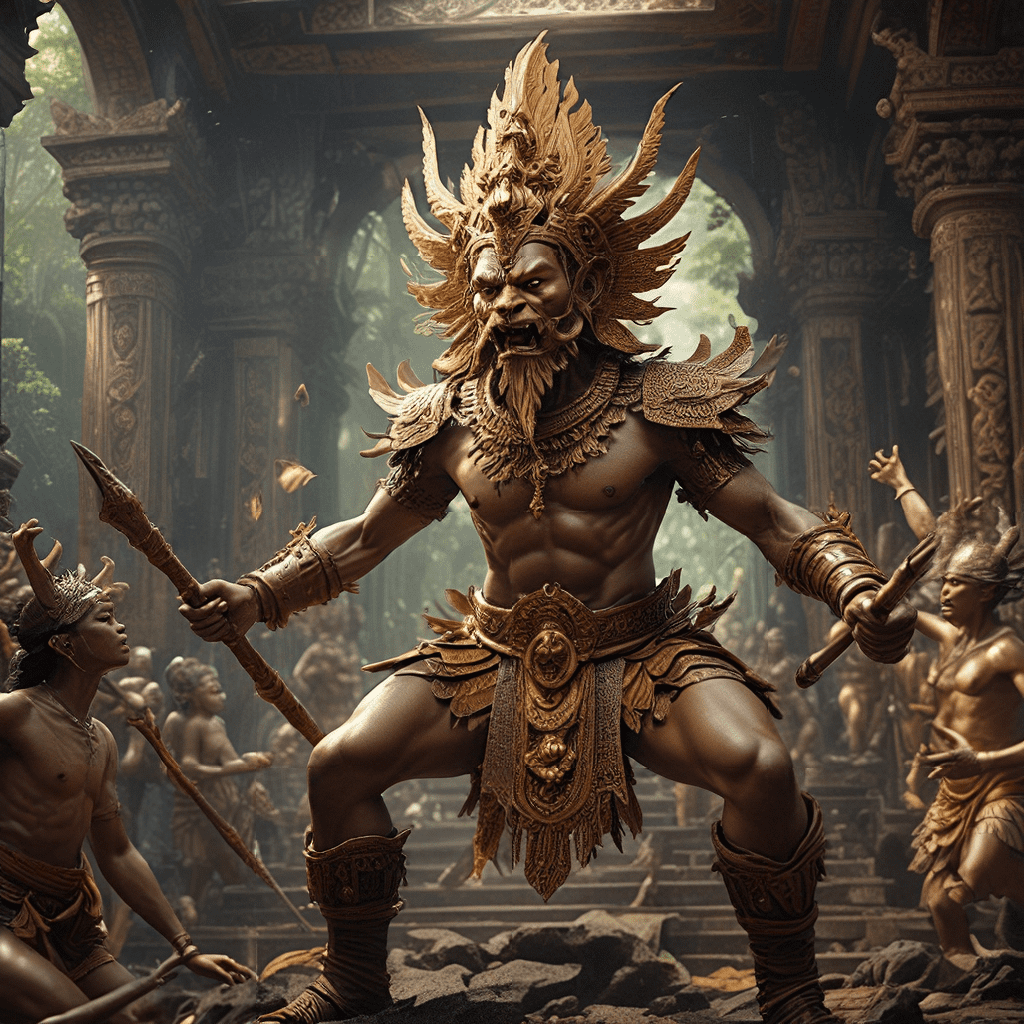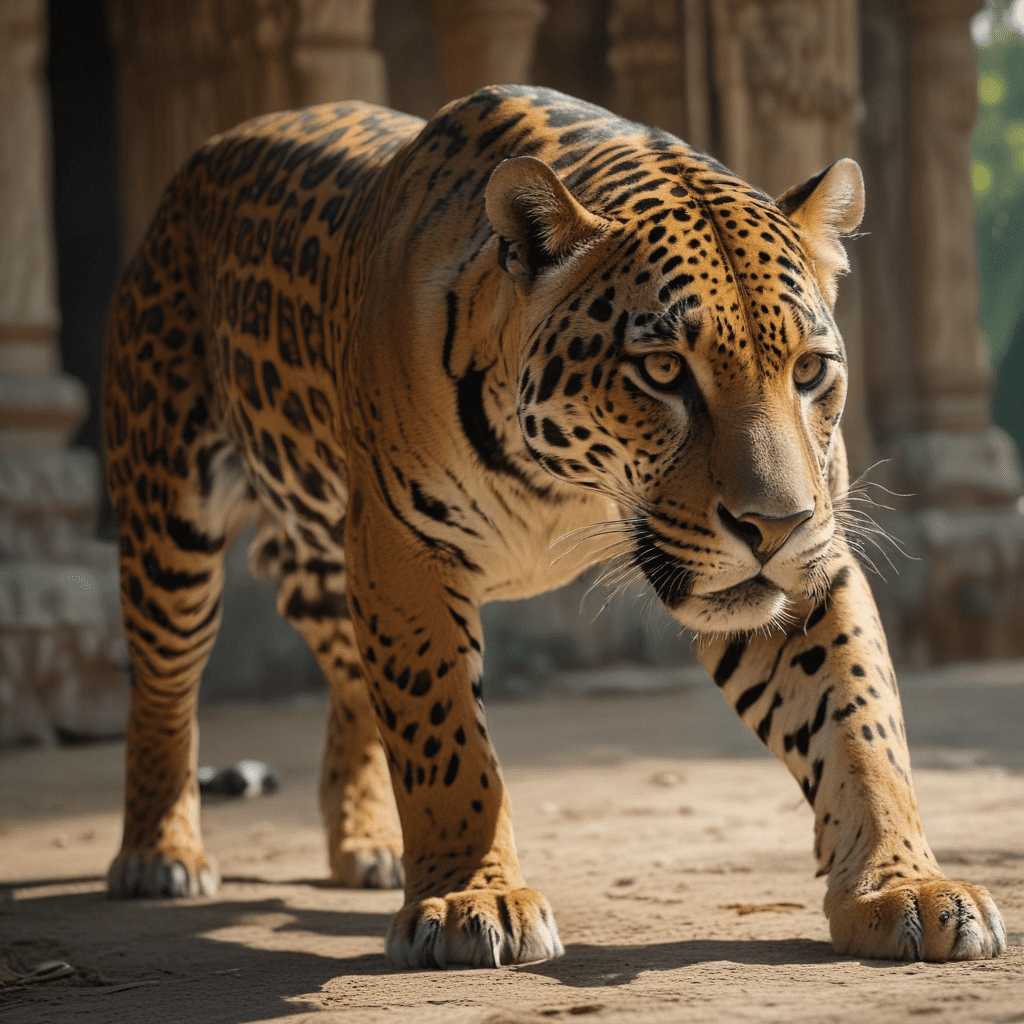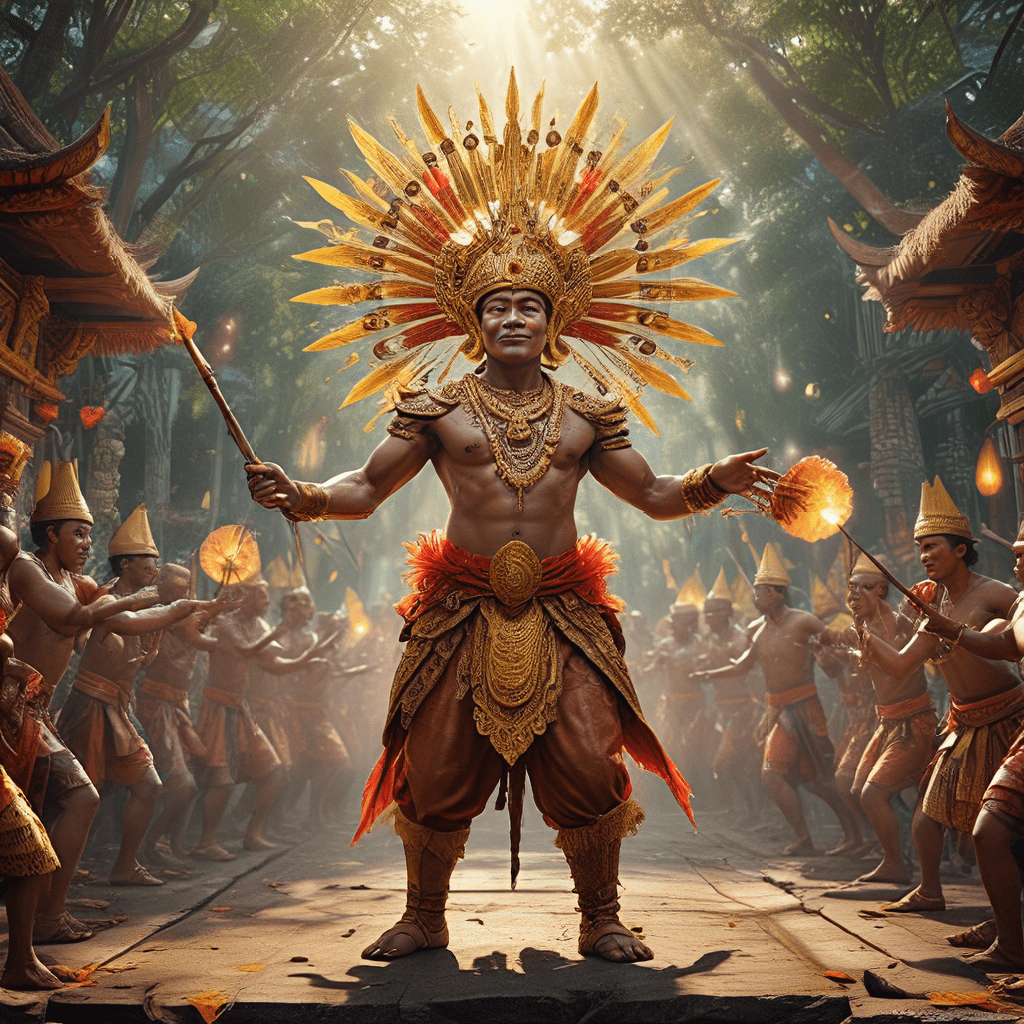Indonesian Mythology: Chaos, Order, and the Cosmic Dance
Indonesian mythology is a rich tapestry woven with stories of creation, gods, and heroes, reflecting a deep understanding of the human condition and the universe. At the heart of these stories lies a dynamic interplay between chaos and order, a constant dance between primal forces that shape the world and the lives of its inhabitants. Exploring this dynamic offers a unique window into Indonesian cultural values, beliefs, and the enduring human quest for balance and meaning.
The Cosmic Egg: From Primordial Chaos to Creation
Many Indonesian creation myths begin with a state of primordial chaos, a vast emptiness where nothing existed. This chaos is often personified as a cosmic egg, a symbol of potential and the raw materials of existence. Within this egg, the forces of creation and destruction are locked in an eternal struggle, awaiting the moment of emergence. In some myths, the god Batara Guru, the supreme deity, emerges from this egg, bringing order and structure to the chaos. In others, the egg is broken by a divine being, freeing the elements and giving rise to the world and its inhabitants.
The concept of the cosmic egg highlights the essential duality of chaos and order. Chaos represents the raw, untamed potential of existence, while order signifies structure, organization, and the emergence of life. This primordial struggle is not one of good versus evil, but rather a necessary tension that drives creation itself. Without the initial chaos, there could be no order, and without order, chaos would remain undifferentiated and unformed.
The Role of the Deities: Maintaining Order and Harmony
Indonesian mythology features a vast pantheon of deities, each with their own unique roles and responsibilities. These deities embody different aspects of the natural world, human life, and the cosmic order. They serve as guardians of the balance between the forces of chaos and order, ensuring that the world remains in harmony.
For example, the god Batara Guru, often depicted as a powerful ruler, represents the forces of law, justice, and order. His wife, Dewi Uma, is associated with fertility, creation, and the power of nature. Together, they embody the critical balance between masculine and feminine energies, essential for maintaining harmony in the universe. Other deities, such as the gods of the wind, rain, and the sea, embody the dynamic forces of nature, reminding humans of the power of the natural world and the need to live in harmony with it.
The Importance of Rituals: Preserving Balance in the Face of Chaos
Rituals and ceremonies play a central role in Indonesian mythology, serving as a bridge between the human and divine realms. These rituals are not simply symbolic acts; they are believed to have the power to influence the forces of chaos and order, restoring balance and ensuring the well-being of the community.
Rituals often involve offerings to the deities, prayers for protection and guidance, and dances and songs that celebrate the harmony of nature. These actions are seen as a way to acknowledge the power of the divine and to seek their favor. By engaging in these rituals, individuals and communities believe they can maintain order in their lives and in the world around them. They also act as a reminder of the fragility of the balance between chaos and order, and the need for constant vigilance and respect for the forces that govern the universe.
Mythological Narratives: Exploring the Interplay between Chaos and Order
Indonesian mythology is filled with stories that explore the dynamic interplay between chaos and order. These narratives often feature heroes who battle against malevolent forces, representing the constant struggle against chaos and the preservation of order.
One prominent example is the story of the hero Gatotkaca, a powerful warrior from the epic poem Mahabharata, who embodies the strength and resilience of the human spirit against the forces of darkness. His epic battles against demons and other evil forces serve as a powerful reminder of the enduring human struggle for order and justice. These stories provide valuable lessons about courage, strength, and the importance of protecting the fragile balance between chaos and order. They also highlight the role of individuals in shaping the fate of the world, reminding us that even in the face of chaos, hope and resilience can prevail.
The Shadow Side of Order: Myths of Rebellion and Disruption
Within the Indonesian mythological landscape, the concept of order is not always presented as a benevolent force. Many myths explore the darker side of order, highlighting the potential for oppression, rigidity, and the suppression of individual freedom. These stories often depict rebellious characters who challenge the established order, questioning authority and seeking to break free from the constraints of tradition.
The myth of the giant Bujangga, for instance, narrates the story of a powerful warrior who rebelled against the unjust rule of a tyrannical king. Bujangga's rebellion, while ultimately unsuccessful, serves as a reminder that even in a society governed by order, there can be injustices that need to be challenged. These myths act as a cautionary tale, reminding communities that order must be balanced with fairness, compassion, and the recognition of individual needs.
The myth of the rebellious princess, Dewi Sekartaji, offers another perspective. She defies her father's orders, choosing to pursue her own destiny and defy societal expectations. While her actions disrupt the established order, they also challenge the rigid norms of her time, advocating for individual freedom and the right to self-determination. These stories of rebellion and disruption highlight the complexities of order, demonstrating that it can be both a source of stability and a tool for oppression. They remind us that true order must be built upon a foundation of justice, freedom, and the recognition of the unique needs and aspirations of individuals.
The Concept of Dharma: Moral Order and Cosmic Justice
Throughout Indonesian mythology, the concept of Dharma plays a vital role in shaping the understanding of order. Dharma, which translates roughly to "righteousness," "duty," or "cosmic law," can be understood as the moral order that governs the universe and human life. It encompasses the principles of right and wrong, the responsibilities of individuals to themselves and their communities, and the consequences of actions in the present and future. Dharma is not simply a set of rules or regulations; it is a dynamic force that guides individuals towards living in harmony with themselves, each other, and the natural world.
The concept of Dharma is interwoven with the understanding of karma, the law of cause and effect. Every action, thought, and intention has consequences, creating a ripple effect that impacts not only the individual but also the world around them. Dharma and karma work together to create a sense of cosmic justice, where actions have repercussions and individuals are ultimately responsible for the consequences of their choices. This concept serves as a strong motivator for ethical behavior, encouraging individuals to strive for righteousness, compassion, and balance in their actions.
The importance of Dharma in Indonesian mythology lies in its ability to connect individual choices and actions to the broader cosmic order. By living in accordance with Dharma, individuals play their part in maintaining the balance between chaos and order, ensuring the well-being of the community and the harmony of the universe.
Folklore and Mythology: Reflecting the Human Struggle for Order
Indonesian folklore and mythology are not simply tales to entertain; they are reflections of the human experience, the challenges we face, and the values we hold dear. Throughout these stories, the struggle between chaos and order is a recurring theme, representing the everyday realities of life. From the everyday tasks of farming and fishing to the more complex challenges of managing relationships and navigating societal expectations, humans are constantly seeking to create order in a world that is often chaotic and unpredictable.
Folklore, in particular, provides a window into the daily lives of ordinary people, highlighting the challenges and triumphs of everyday existence. These stories often feature characters who embody the human struggle for order: the farmer who battles against the forces of nature to ensure a successful harvest, the fisherman who strives to find balance between the demands of the sea and the needs of his family, and the community leader who seeks to maintain harmony and justice within their community.
These stories not only offer insight into the human condition but also serve as a source of wisdom, providing guidance and inspiration for navigating the complexities of life. They remind us that the quest for order is a universal human experience, and that finding a balance between chaos and order is an essential part of living a meaningful and fulfilling life.
The Influence of Hinduism and Buddhism: Shaping Indonesian Concepts of Order
Indonesian mythology has been deeply influenced by Hinduism and Buddhism, two major religious traditions that have shaped the country's cultural landscape for centuries. Both religions emphasize the importance of order, harmony, and moral living, shaping the Indonesian understanding of chaos and order.
Hinduism, with its complex system of deities, rituals, and social hierarchy, has contributed to the concept of cosmic order. The concept of Dharma, discussed earlier, is a cornerstone of Hindu philosophy, emphasizing the importance of righteous conduct and fulfilling one's duties. The Hindu pantheon of gods, each with their own roles and responsibilities, reflects the complex interplay of forces that govern the universe. The central role of deities in maintaining order and balance resonates deeply with Indonesian mythology, contributing to the understanding of the divine as a force that shapes and guides the world.
Buddhism, with its emphasis on enlightenment, compassion, and the interconnectedness of all things, contributes to the understanding of order as a state of balance and harmony. The Buddhist concept of karma, the law of cause and effect, echoes the Indonesian understanding of the consequences of actions, both individual and collective. The Buddhist ideal of achieving enlightenment through the practice of meditation and ethical conduct aligns with the Indonesian emphasis on inner peace and spiritual harmony as essential components of a well-ordered life.
Contemporary Relevance: Understanding Chaos and Order in Modern Indonesian Life
The concepts of chaos and order are not simply relics of ancient myths and legends. They remain relevant in modern Indonesian life, shaping the country's social, political, and economic realities. In a rapidly changing world, Indonesia faces challenges such as rapid urbanization, environmental degradation, and economic inequality, all of which contribute to a sense of chaos and uncertainty.
The ancient myths and stories, however, offer valuable insights and guidance for navigating these challenges. They remind us of the importance of finding balance between tradition and innovation, reconciling individual needs with the collective good, and striving for a just and equitable society. The emphasis on harmony and respect for the natural world found in Indonesian mythology resonates with contemporary environmental concerns, encouraging a more sustainable and responsible approach to development.
The enduring relevance of the concepts of chaos and order in modern Indonesian life highlights their universality and timeless significance. As individuals and communities confront the challenges of the 21st century, understanding the interplay of these forces becomes more important than ever. Indonesian mythology offers a rich and insightful framework for navigating the complexities of modern life, encouraging us to seek balance, harmony, and meaning in a world that is often chaotic and unpredictable.
FAQ
How does Indonesian mythology explain the creation of the world?
Many Indonesian creation myths describe a primordial state of chaos represented by a cosmic egg. From this egg, deities emerge, bringing order and structure to the universe.
What is the role of deities in Indonesian mythology?
Deities in Indonesian mythology represent various aspects of nature, human life, and the cosmic order. They act as guardians of balance, ensuring harmony between chaos and order.
How do rituals and ceremonies contribute to the concept of order?
Rituals act as a bridge between the human and divine realms, believed to influence the forces of chaos and order. They involve offerings, prayers, and celebrations, signifying respect for the divine and seeking their favor.
What are some prominent myths that explore the interplay between chaos and order?
The stories of Gatotkaca, the rebellious princess Dewi Sekartaji, and the giant Bujangga highlight the constant struggle against chaos and the quest for order. They emphasize the importance of courage, resilience, and challenging injustice.
How does the concept of Dharma relate to order in Indonesian mythology?
Dharma represents the moral order that governs the universe and human life, emphasizing righteousness, duty, and the consequences of actions. It encourages individuals to live ethically and contribute to cosmic balance.
What are the contemporary implications of understanding chaos and order in Indonesian mythology?
The ancient concepts offer valuable insights into navigating modern challenges like urbanization, environmental degradation, and economic disparity. They encourage balance between tradition and innovation, fostering a just and sustainable society.



